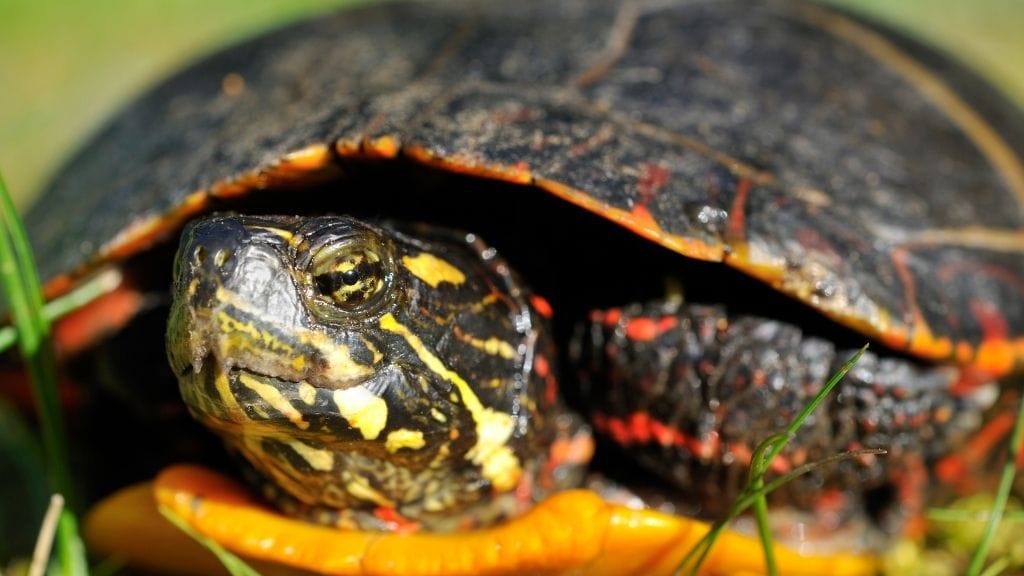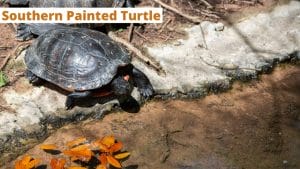Chrysemys picta (Painted Turtle)
Home > Turtle Database > Chrysemys picta (Painted Turtle)
Chrysemys Picta, commonly known as the painted turtle, is renowned for its strikingly colorful markings on its extremities, neck, and shell. These turtles are small to medium in size and are one of the most widely distributed turtle species in North America.
Native To These Regions
Alabama (USA), Alberta (Canada), Arkansas (USA), British Columbia (Canada), Colorado (USA), Connecticut (USA), Delaware (USA), Georgia (USA), Illinois (USA), Indiana (USA), Iowa (USA), Kansas (USA), Kentucky (USA), Louisiana (USA), Maine (USA), Manitoba (Canada), Maryland (USA), Massachusetts (USA), Michigan (USA), Minnesota (USA), Mississippi (USA), Missouri (USA), Montana (USA), Nebraska (USA), New Brunswick (Canada), New Hampshire (USA), New Jersey (USA), New York (USA), Newfoundland and Labrador (Canada), North Carolina (USA), North Dakota (USA), Northwest Territories (Canada), Nova Scotia (Canada), Nunavut (Canada), Ohio (USA), Oklahoma (USA), Ontario (Canada), Pennsylvania (USA), Prince Edward Island (Canada), Quebec (Canada), Rhode Island (USA), Saskatchewan (Canada), South Carolina (USA), South Dakota (USA), Tennessee (USA), Texas (USA), Vermont (USA), Virginia (USA), West Virginia (USA), Wisconsin (USA), Wyoming (USA), Yukon (Canada)Native Turtle Species Map – Find Turtles by Region
Scientific Classification
- Kingdom: Animalia
- Phylum: Chordata
- Class: Reptilia
- Order: Testudines
- Family: Emydidae
- Genus: Chrysemys
- Species: C. picta
Common Names
- Painted Turtle
This Hilarious Turtle Book Might Know Your Pet Better Than You Do
Let’s be real—most turtle care guides feel like reading a textbook written by a sleep-deprived zookeeper.
This one’s not that.
Told from the snarky point of view of a grumpy, judgmental turtle, 21 Turtle Truths You’ll Never Read in a Care Guide is packed with sarcasm, sass, and surprisingly useful insights.
And hey—you don’t have to commit to the whole thing just yet.
Grab 2 free truths from the ebook and get a taste of what your turtle really thinks about your setup, your food choices, and that weird plastic palm tree.
It’s funny, it’s honest, and if you’ve ever owned a turtle who glares at you like you’re the problem—you’ll feel seen.
Identification
- Description: Painted turtles have a smooth, flat shell with a colorful pattern of red, green, and yellow. They typically measure 4 to 10 inches in length.
- Sexual Dimorphism: Females are generally larger than males, and males have longer and thicker tails.
Check more turtles from the Chrysemys genus
Native Origin and Distribution
- Geographical Range: The painted turtle is native to North America, found from southern Canada through the U.S. to northern Mexico.
Preferred Habitat
Painted turtles prefer freshwater habitats with abundant aquatic vegetation, including ponds, lakes, marshes, and slow-moving rivers.
Behavior
- Feeding Habits: They are omnivorous, primarily feeding on aquatic vegetation, insects, and small aquatic creatures.
- Predators: Common predators include raccoons, foxes, and birds of prey.
Reproduction
- Breeding Season: Breeding occurs from late spring to early summer.
- Reproductive Method: Females lay eggs in sandy or muddy soil, often in well-sunlit areas.
Conservation
- Extinction Status: Not currently at risk of extinction and classified as Least Concern by the IUCN.
- Threats: Habitat loss, pollution, and road mortality.
- Conservation Measures: Protection of natural habitats and community involvement in conservation efforts.
Economic Importance
Painted turtles contribute to the local ecosystem by helping control insect populations and serving as both predator and prey within their food web. They also have aesthetic and educational value, enhancing outdoor recreational experiences.
Interesting Facts
- Painted turtles can hibernate in the mud at the bottom of ponds and lakes during the winter, surviving with very low oxygen levels.
Research Studies
For a detailed study on painted turtles, you can refer to this research paper: The Evolutionary and Mathematical Demography of the Turtle Chrysemys picta

About Author
Muntaseer Rahman started keeping pet turtles back in 2013. He also owns the largest Turtle & Tortoise Facebook community in Bangladesh. These days he is mostly active on Facebook.













